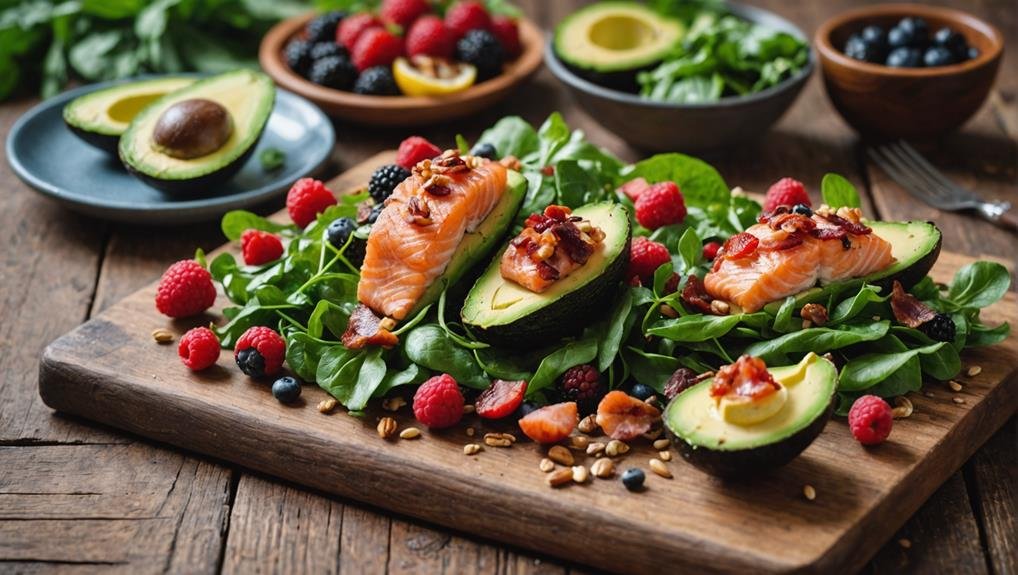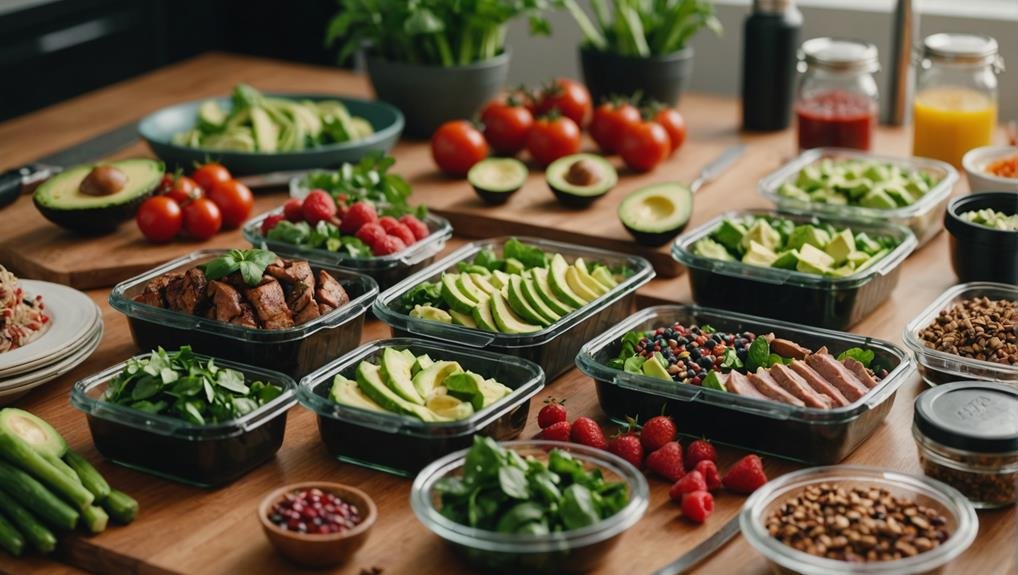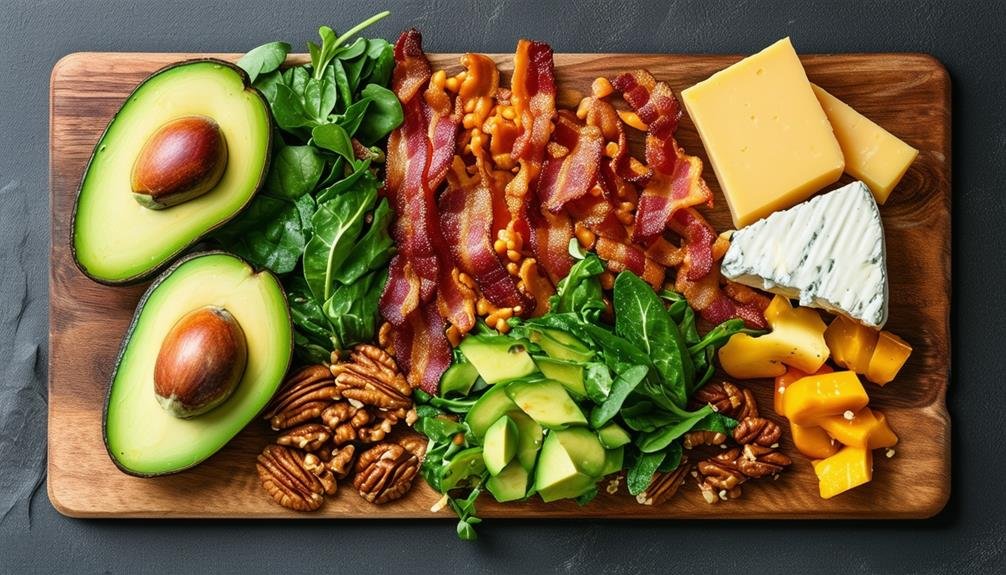On a ketogenic diet, prioritize high-quality proteins like red meat, poultry, fatty fish, and eggs.
Incorporate healthy fats from sources such as olive oil, avocados, nuts, and full-fat dairy. These food choices promote feelings of fullness and help you maintain a daily carb intake of 20-50 grams.
It's crucial to avoid sugary snacks, grains, starchy foods, and sweetened beverages, as these can hinder your ability to achieve and maintain ketosis.
To enhance your chances of success, consider planning your meals and tracking your macronutrients. By utilizing these strategies, you can effectively manage your diet and reap the associated health benefits.
Key Takeaways
- Prioritize high-quality protein sources, including fatty fish, red meat, poultry, and eggs, to fulfill your nutritional requirements effectively.
- Add healthy fats like olive oil, avocados, nuts, and full-fat dairy to enhance feelings of fullness and provide sustained energy.
- Eliminate sugary snacks, grains, and starchy foods to maintain a low carbohydrate intake, which is crucial for entering and sustaining ketosis.
- Organize your meals ahead of time to ensure a proper balance of high-fat foods while keeping your carbohydrate intake between 20-50 grams per day.
Understanding Ketogenic Principles
To effectively understand ketogenic principles, it's essential to recognize how significantly reducing carbohydrate intake transitions your body into a fat-burning state known as ketosis.
The ketogenic diet typically comprises a macronutrient distribution of approximately 70% fat, 20% protein, and only 10% carbohydrates. By lowering your carbohydrate consumption to around 20-50 grams daily, you create optimal conditions for ketosis, wherein your body primarily utilizes fat for energy rather than carbohydrates.
As you embark on the ketogenic diet, it's vital to closely examine food labels to monitor carbohydrates in various foods. This knowledge will assist you in making informed choices that align with your dietary goals.
With reduced carb intake, your liver starts to produce ketones, which serve as your main energy source. There are different variations of the ketogenic diet, including the Standard Ketogenic Diet (SKD), Cyclical Ketogenic Diet (CKD), and Targeted Ketogenic Diet (TKD), each tailored to fit diverse lifestyle needs and activity levels, allowing for a personalized approach to achieving ketosis.
In the early stages, you might notice significant weight loss, largely attributed to a reduction in water weight. As you maintain the diet, the weight loss will progressively transition to fat loss.
Although adopting a high-fat, low-carb eating plan may appear daunting initially, comprehending these foundational ketogenic principles will facilitate your nutritional journey. By adhering to the correct macronutrient distribution and closely monitoring carbohydrate intake, you'll enhance your chances of experiencing a successful ketogenic journey.
Health Benefits of Keto
The ketogenic diet offers a variety of health benefits, ranging from significant weight loss to improved blood sugar regulation and enhanced cognitive function. One of the primary advantages of the keto diet is its effectiveness in promoting weight loss. Research indicates that individuals adhering to a ketogenic diet can lose an average of 2 more pounds compared to those following low-fat diets over comparable durations. Additionally, the ketogenic approach enhances insulin sensitivity, making it particularly advantageous for individuals managing type 2 diabetes.
The ketogenic diet also supports cardiovascular health by lowering triglyceride levels while simultaneously raising HDL (good) cholesterol. This beneficial change positively impacts heart health and overall wellness. Furthermore, the keto diet is recognized for its neurological advantages; it has proven effective in reducing seizure frequency in children with epilepsy and may help alleviate symptoms associated with neurodegenerative diseases such as Alzheimer's and Parkinson's.
Many individuals report improved mental clarity and focus while adhering to a ketogenic lifestyle, attributed to the consistent energy levels derived from fat metabolism during ketosis.
Below is a summarized overview of the health benefits associated with the ketogenic diet:
| Health Benefit | Description |
|---|---|
| Weight Loss | Individuals lose an average of 2 pounds more than those on low-fat diets. |
| Insulin Sensitivity | Enhanced control for individuals with type 2 diabetes. |
| Cardiovascular Health | Decreased triglyceride levels and increased HDL cholesterol. |
| Neurological Benefits | May reduce seizures in epileptic patients and improve neurological function. |
| Mental Clarity | Improved focus attributed to stable energy levels from fat metabolism. |
Foods to Include

To successfully follow a keto diet, it's crucial to include the right foods in your meal plan.
Focus on high-quality protein sources such as meat, poultry, and fatty fish, which provide essential nutrients while keeping carbohydrate intake low.
Additionally, incorporate healthy fats from dairy products, nuts, and seeds to help you feel full and support overall well-being, all while adhering to your dietary goals.
Top Keto Protein Sources
Incorporating a diverse range of top protein sources is vital for maintaining satisfaction and nutritional balance in your ketogenic diet. These options are low in carbohydrates and high in healthy fats, crucial for a successful keto lifestyle.
Here are three standout protein sources to consider:
- Meat and Poultry: Fresh selections such as red meat, chicken, turkey, and bacon are devoid of carbs and rich in protein, making them foundational components of a keto diet.
- Fatty Fish: Types like salmon, mackerel, and sardines not only provide a significant amount of protein but are also abundant in omega-3 fatty acids. These healthy fats can enhance heart health and help regulate insulin levels.
- Eggs: With fewer than 1 gram of carbs and approximately 6 grams of protein per large egg, eggs are excellent for promoting satiety while supplying essential nutrients, including lutein and zeaxanthin, which are beneficial for eye health.
In addition to these protein sources, incorporating dairy products such as cheddar cheese, which contains about 1 gram of carbs per serving, along with low-carb nuts and seeds, can further enhance your meals.
Healthy Fats Options
Healthy fats are essential components of your ketogenic diet, providing energy while promoting satiety. To successfully follow this diet, incorporate a variety of healthy fat sources into your meals.
Start with olive oil, known for its high monounsaturated fat content, which supports heart health. Coconut oil is another excellent option, offering sustained energy and a unique flavor profile.
Avocados deserve mention as well; they're rich in monounsaturated fats and low in carbohydrates – just half an avocado contains approximately 6 grams of total carbs, making it an ideal keto-friendly food.
For snacking, nuts and seeds such as macadamia nuts and chia seeds are superb choices, as they're low in net carbs and high in healthy fats.
Including full-fat dairy in your diet is beneficial too. Cheese is advantageous, often containing less than 1 gram of carbs per serving. Heavy cream and butter not only add richness to your meals but also provide healthy fats.
Lastly, fatty fish like salmon and mackerel are exceptional sources of omega-3 fatty acids, which support brain health and help lower insulin levels.
Incorporating these healthy fats into your diet will help maintain your energy levels and overall satisfaction on your keto journey.
Foods to Avoid
When following a keto diet, it's crucial to avoid certain foods that can hinder your progress.
Specifically, steer clear of sugary snacks and beverages, as well as grains and starchy foods, which are high in carbohydrates.
Sugary Foods and Beverages
Sugary foods and beverages can significantly hinder your ketogenic diet by elevating your carbohydrate intake and interrupting your body's state of ketosis. These items typically contain substantial amounts of sugar, which can trigger blood sugar surges, making it difficult to sustain fat burning.
To effectively support your keto journey, it's crucial to steer clear of the following:
- Soda and Sweetened Beverages: A single serving can contain up to 39 grams of sugar, often surpassing your daily carbohydrate allowance.
- Fruit Juice: Natural fruit juices may seem healthy but often have a high carb count that can add up quickly.
- Desserts: Foods like cakes and ice cream are typically high in sugar and may also include hidden carbohydrates from flour and other starchy ingredients.
To maintain ketosis, focus on consuming sugar-free snacks and unsweetened beverages.
It's essential to keep your total daily carbohydrate intake within the recommended range of 20-50 grams to remain aligned with the ketogenic diet.
Grains and Starchy Foods
Grains and starchy foods can significantly disrupt your ketogenic diet by raising your carbohydrate levels, making it challenging to maintain ketosis. Foods such as bread, pasta, and rice are high in carbohydrates and should be avoided to keep your carb intake low. Furthermore, starchy vegetables like potatoes, corn, and peas also contain considerable amounts of net carbs, which can impede your progress.
Many cereals and baked goods are problematic due to the presence of hidden sugars and refined grains. These processed foods can easily push your daily carb consumption beyond the recommended limit of 20-50 grams, hindering your ketogenic state. Sweetened beverages, including sodas and fruit juices, further contribute to hidden sugars that can quickly spike your carbohydrate intake.
It is crucial to read labels carefully and avoid foods that may appear healthy but contain added sugars or refined carbohydrates. By avoiding grains, starchy foods, and processed options, you can ensure that your diet remains aligned with your ketogenic objectives.
Maintaining low net carb levels will facilitate your stay in ketosis and enhance the benefits of a ketogenic lifestyle.
Tips for Meal Preparation

Planning your meals in advance is crucial for staying organized and ensuring a variety of keto-friendly options throughout the week. By implementing effective meal prep strategies, you can create balanced meals rich in healthy fats, proteins, and low-carb vegetables.
Here are three practical tips to enhance your meal preparation:
- Batch Cooking: Dedicate time each week to prepare large quantities of your favorite keto meals. Cooking in bulk minimizes the number of times you need to prepare food during the week, helping you remain consistent with your meal plan.
- Portion Control: Once your meals are cooked, portion them into individual containers. This simplifies your daily routine and helps you track your macronutrient intake. Ensure your portions align with your daily goals, typically 70% fat, 25% protein, and 5% carbohydrates.
- Meal Diversity: Explore keto-friendly alternatives, such as using almond flour for baking or shirataki noodles instead of traditional pasta. This approach not only adds variety to your meals but also keeps your carbohydrate intake low.
Additionally, consider maintaining a food journal or utilizing apps to monitor your daily consumption, helping you stay within your macro guidelines.
By following these meal prep tips, you'll streamline your planning process, uphold the principles of your keto diet, and enjoy discovering new tastes and combinations.
Success on the keto diet relies on finding a system that suits your individual needs.
Ensuring Diet Success
Successfully following the keto diet requires a solid understanding of food choices and effective tracking of your macronutrient intake.
Crafting a detailed meal plan will assist you in incorporating high-fat foods while maintaining appropriate net carb levels. It's essential to limit your daily net carb intake to between 20-50 grams to achieve and sustain ketosis. Familiarizing yourself with nutrition labels will aid in recognizing the suitable fat, carb, and fiber content for a successful ketogenic diet.
To help you stay accountable, consider utilizing apps or journals to record your daily macronutrient consumption, aiming for a distribution of approximately 70% fat, 25% protein, and 5% carbohydrates. This meticulous monitoring plays a critical role in guiding your food selections.
Staying well-hydrated is crucial, as dehydration can lead to fatigue and irritability. Introducing electrolyte supplements during the initial adjustment phase may alleviate 'keto flu' symptoms commonly experienced in the early stages.
Moreover, establishing a support network can significantly enhance your adherence to the diet. Joining online forums or local meet-up groups focused on the ketogenic lifestyle offers opportunities to exchange advice, seek answers to your questions, and maintain motivation.
Engaging with a supportive community creates a framework for accountability, making it easier to remain dedicated to your dietary goals. By combining informed food choices, careful tracking, proper hydration, and community support, you can greatly improve your likelihood of success on your ketogenic journey.
Frequently Asked Questions
What Is the Best First Meal for Keto?
For a satisfying keto breakfast, prepare scrambled eggs cooked in butter, alongside ripe avocado and sautéed spinach. Consider incorporating quick keto meals or keto-friendly smoothies to maintain low carbohydrate intake while maximizing flavor!
What Foods to Eat to Start Ketosis?
To effectively initiate ketosis, prioritize consuming low-carb vegetables such as spinach, and include healthy fats like avocados in your diet. Opt for protein-rich foods, with salmon being an excellent choice. Additionally, consider incorporating dairy products that are compatible with a keto diet, alongside keto-friendly snacks and fiber-rich foods, to help you feel full and satisfied throughout the day.
What Should I Eat First in the Morning on Keto?
For a delicious and nutritious keto breakfast, consider incorporating egg-based dishes or recipes featuring avocado. Low carb smoothies and chia seed pudding are also excellent options. Additionally, don't overlook bulletproof coffee and nut butter for enhanced flavor and energy to kickstart your day!
What Are the Top 10 Keto Foods?
Keto foods serve as your essential nutritional guide. Incorporate fatty fish, almond flour, chia seeds, and leafy greens into your meals. Utilize coconut oil, grass-fed butter, and cauliflower rice for cooking. Indulge in a variety of cheeses and opt for low-carb snacks to maintain a flavorful and satisfying ketogenic diet.
Conclusion
Switching to a keto diet can initially feel daunting, particularly when you're giving up beloved foods like bread and pasta.
However, you'll soon discover a diverse range of tasty alternatives that make meal planning enjoyable.
While it may seem limiting to reduce carbohydrates, this dietary change can introduce you to an exciting variety of high-fat, low-carb options.
As you explore this new way of eating, you might find that these dietary shifts can lead to enjoyable and innovative cooking experiences.
